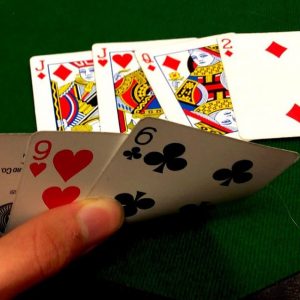Stud Strategy – Playing Straight Starter Hands

Last week, we began our series on Seven Card Stud strategy by looking at playing pairs in Stud. This week, we will take a look at playing straight starters.
Three card straight starter hands can be one of the more speculative hands to play in the game, but if you know how to play them wisely, you can take down big pots when the hands complete.
Open-Ended Straight Starters
Open-ended straight starter hands have no gaps and can catch cards from either end. Hands like 6-7-8, 10-J-Q, or 3-4-5 are prime examples of these hands. The best version of these hands allows you to catch more than one card each way.
In the example of 6-7-8, you can catch a 4, 5, 9, or 10 and still be in good shape to continue your draw. You don’t want to go more than two cards deep with your outs because it makes it much more difficult to fill your draw. For our example, you would not want to try and continue after catching a three because you will have to catch near perfect to fill your draw.
Single card open-enders such as 2-3-4 and J-Q-K are fine to play, but you have fewer outs to complete your hand.
Gap Starters
Gap straight starters come in two flavors, single and double gappers. A single gap hand is a hand such as 4-6-7 or 10-Q-K. Double gapper example include 4-6-8, 2-4-6, and 9-J-K. For gap hands, you don’t want more than a single card in your gap. Hands like 6-9-10 or 5-8-9 are also considered double gappers.
If your hand has more than a two-card gap, such as 5-9-10, this is not a straight draw because you have to catch three cards to catch your straight. These should be largely folded.
For gap hands, you’re looking to improve immediately and they are not hands you want to play with a lot of action.
Higher Straight Starters Are Preferable
When you first start playing Seven Card Stud, you don’t want to play every single straight draw until you have a better feel of the game. By and large, you’re looking for straight draws with higher cards in them.
For example, a straight starter of 10-J-Q is much better than 5-6-7. If you happen to back into two pair with Q-J-10, it has a much better chance of winning. If your queen is a door card and you pair, you may be able to take the pot down right away since you can represent a big hand like trips.
Count Your Outs
We talked about paying attention to the up cards of your opponents in our last article, and this is a concept that will be repeated throughout our articles on Stud. However, your opponent’s upcards will also help you determine whether to continue with your draw.
Roy Cooke came up with a solid system for continuing with a straight draw. Look around at the cards on your table and assign points based on how they work into your hand. For cards that work for your open-ended draw or for your gap draw, assign any upcard you see at 1 point. Any card that is secondary to your draw, such as a 3 when you hold a 5-6-7, you should assign a half-point.
If you look around and see more than two points on the board, then you should abandon your draw. As an example, assume you have 9-10-J and you look around and see one player with an 8, one with a queen and one player showing a 7. The queen and eight are worth a point each and the 7 is worth a half-point. That’s two and a half points, meaning you should fold.
There are going to be exceptions to this rule, but this isn’t the time to discuss those. For now, you should establish a solid base for play before worrying about rare occurrences.
Improve by Fifth or Get Out
A key concept to remember playing Seven Card Stud is that you need to improve by Fifth Street or you need to fold your hand. If you don’t improve by fifth, you will have to catch runner-runner to hit your hand.
Note that improvement doesn’t always mean catching part of your straight. If you start with K-Q-J and catch a king on Fourth Street, you have enough of a reason to continue provided your opponent isn’t showing massive strength or a better hand. However, if you haven’t picked up at least a big pair or part of your draw, get out on Fifth Street.
Next week, we will take a look at playing flush starter hands in Seven Card Stud. See you then!
